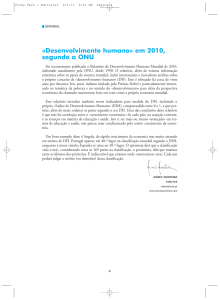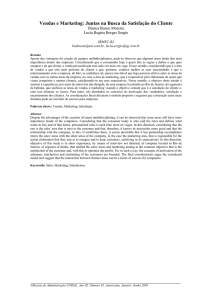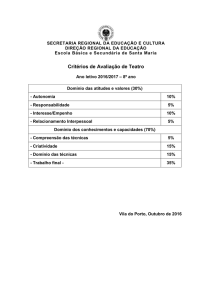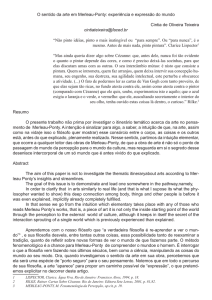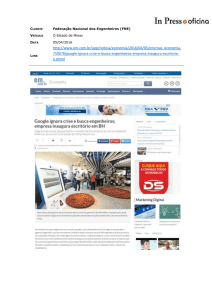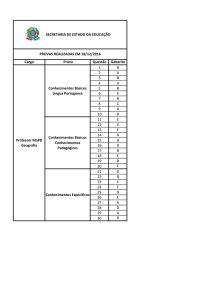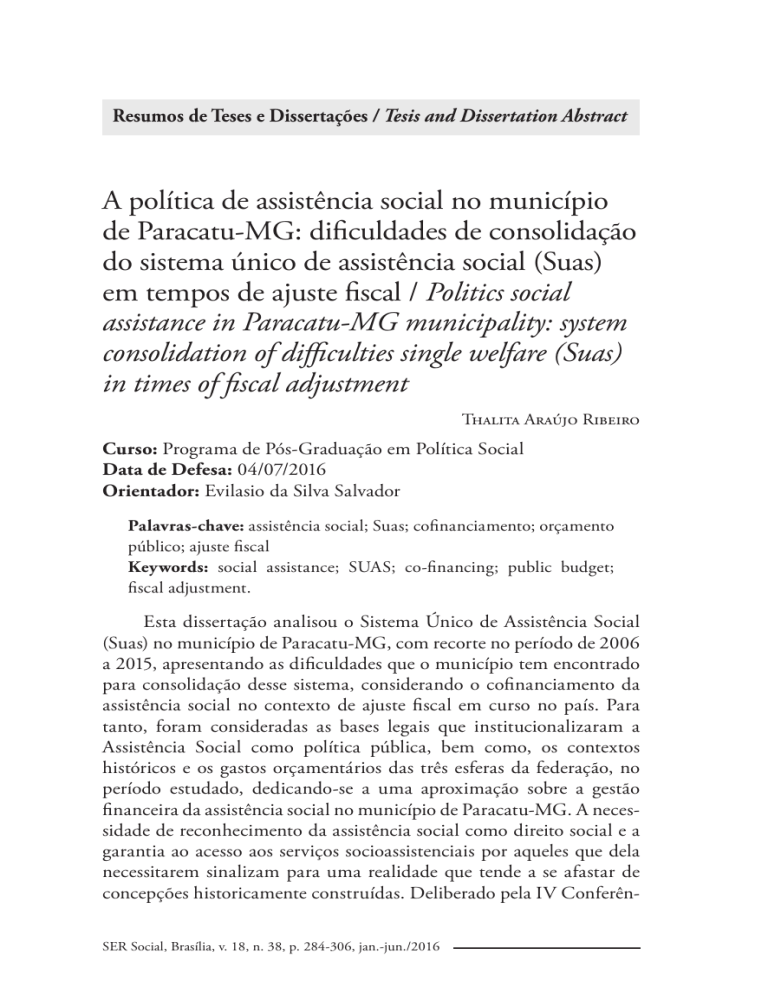
Resumos de Teses e Dissertações / Tesis and Dissertation Abstract
A política de assistência social no município
de Paracatu-MG: dificuldades de consolidação
do sistema único de assistência social (Suas)
em tempos de ajuste fiscal / Politics social
assistance in Paracatu-MG municipality: system
consolidation of difficulties single welfare (Suas)
in times of fiscal adjustment
Thalita Araújo Ribeiro
Curso: Programa de Pós-Graduação em Política Social
Data de Defesa: 04/07/2016
Orientador: Evilasio da Silva Salvador
Palavras-chave: assistência social; Suas; cofinanciamento; orçamento
público; ajuste fiscal
Keywords: social assistance; SUAS; co-financing; public budget;
fiscal adjustment.
Esta dissertação analisou o Sistema Único de Assistência Social
(Suas) no município de Paracatu-MG, com recorte no período de 2006
a 2015, apresentando as dificuldades que o município tem encontrado
para consolidação desse sistema, considerando o cofinanciamento da
assistência social no contexto de ajuste fiscal em curso no país. Para
tanto, foram consideradas as bases legais que institucionalizaram a
Assistência Social como política pública, bem como, os contextos
históricos e os gastos orçamentários das três esferas da federação, no
período estudado, dedicando-se a uma aproximação sobre a gestão
financeira da assistência social no município de Paracatu-MG. A necessidade de reconhecimento da assistência social como direito social e a
garantia ao acesso aos serviços socioassistenciais por aqueles que dela
necessitarem sinalizam para uma realidade que tende a se afastar de
concepções historicamente construídas. Deliberado pela IV ConferênSER Social, Brasília, v. 18, n. 38, p. 284-306, jan.-jun./2016
285
cia Nacional de Assistência Social de 2003, a implementação do Suas é
orientada por princípios estabelecidos pela Lei Orgânica da Assistência
Social (Loas), considerados na Política Nacional de Assistência Social
(PNAS) e é organizado pela Norma Operacional Básica (NOB/Suas).
O Suas deve ter a gestão das ações baseando-se na descentralização
político-administrativa, a participação e o cofinanciamento. Assim, no
âmbito do cofinanciamento, verificou-se que entre todos os entes da
federação, os estados têm apresentado pouca evolução na participação
do financiamento da assistência social. Considerou-se também o debate
em torno do fundo público, buscando compreender sua funcionalidade, principalmente em tempos de priorização de políticas econômicas, com estratégias de ajustes fiscais. Os resultados identificados foram
que, em Paracatu-MG, as principais dificuldades de consolidação do
Suas são: a maioria das equipes técnicas de referências não estão
completas; expressiva oferta de serviços socioassistenciais por entidades; inexistência de Cras Volante para atendimento da população que
vive em área rural e inexistência de sede própria para os Centros de
Referência Especializados da Assistência Social (Cras), Centro de Referência Especializada da Assistência Social (Creas) e Secretaria Municipal do Desenvolvimento e Ação Social (Sedas).
This thesis analyzed the Single Social Assistance System ( SUAS ) in
the municipality of Paracatu, Minas Gerais, with cut in the period 20062015 , with the difficulties that the municipality has found to consolidate
this system, considering the co-financing of social assistance in the context
of fiscal adjustment underway in the country .Therefore, the legal bases
were considered that institutionalized social assistance as a public policy,
as well as historical contexts and budget expenditures of the three levels of
the federation, in the period studied, dedicated to an approach on the
financial management of social assistance in Paracatu-MG. The need for
recognition of social care as a social right and ensuring access to social assistance services for those who need it signal to a reality that tends to move
away from historically constructed conceptions. Decided by the Fourth
National Conference on Social Assistance 2003, the implementation of
SUAS is guided by principles established by the Organic Law of Social
Assistance (LOAS) , considered the National Social Assistance Policy
(PNAS) and is organized by the Basic Operational Norm (NOB / SUAS).
The SUAS must have the management of actions based on the political and
administrative decentralization, participation and co-financing. Thus,
SER Social, Brasília, v. 18, n. 38, p. 284-306, jan.-jun./2016
286
Resumo de Teses e Dissertações
under the co-financing, it was found that among all the entities of the
federation, the states have shown little improvement in the share of funding
for social assistance. O. It was also considered the debate surrounding the
public fund, seeking to understand its functionality, especially in prioritizing times of economic policies, with strategies of fiscal adjustments. The
results were identified that in Paracatu-MG, the main difficulties SUAS
consolidation are most technical references teams are not complete; significant supply socioassitencias services by entities; lack of CRAS Volante to
meet the population living in rural areas and lack of proper headquarters
for the Specialized Reference Centers of Social Assistance (CRAS), Reference Center for Specialized Social Assistance (CREAS) and the Municipal Development and Social Action (SEDAS).
Desdobramentos da adesão do Governo
do Distrito Federal à Política Nacional para
População em Situação de Rua / Consequences
of the accession of the Distrito Federal the
National Policy on Population Homeless
Fabricia da Hora Pereira
Curso: Programa de Pós-Graduação em Política Social
Data da Defesa: 17/02/2016
Orientadora: Maria Lúcia Lopes Pereira da Silva
Palavras-chave: pessoas em situação de rua; política social; Distrito
Federal
Keywords: people in homeless; social policy; Federal District
Esta dissertação propõe analisar os desdobramentos da adesão do
Governo do Distrito Federal à Política Nacional para a População em
Situação de Rua. Dessa forma, o estudo perpassou o entendimento
sobre o fenômeno população em situação de rua a partir da análise
marxiana sobre a acumulação primitiva e o pauperismo. Essa base
analítica permitiu compreender que o fenômeno população em situa-
SER Social, Brasília, v. 18, n. 38, p. 284-306, jan.-jun./2016
287
ção de rua é resultado dos processos de exploração e precarização
acometidos ao trabalhador e é inerente ao modo de produção capitalista. Nesse sentido, esta dissertação traz o perfil contemporâneo da
população em situação de rua a partir do Censo da População em
Situação de Rua do Distrito Federal (2010), além de destacar o contexto
das mudanças ocorridas no capitalismo, em anos recentes. Foram
consideradas as particularidades da formação sócio-histórica do
Distrito Federal e as recentes configurações das políticas sociais e do
Estado. A pesquisa realizada teve natureza documental e como principais fontes de dados foram utilizados documentos oficiais disponibilizados pelas Secretarias de Estado do Distrito Federal e pelo Movimento
Nacional da População em Situação de Rua, como atas de reuniões,
legislações e relatórios de gestão. Recorreu-se ainda à literatura especializada sobre o tema e a outras bases de dados como, o Instituto Brasileiro de Geografia e Estatística e a Secretaria de Direitos Humano da
Presidência da República. O desvelamento do objeto ocorreu a partir
da relação entre as bases de dados referidas e os seguintes eixos norteadores: 1- Direitos previstos e implementados; 2- Abrangência dos direitos; 3- Ação intersetorial entre as políticas; 4- Gestão e controle social;
e 5- Financiamento. O percurso teórico-metodológico realizado possibilitou a confirmação da hipótese inicial: a adesão do Governo do
Distrito Federal à Política Nacional para a População em Situação de
Rua, apesar de ter representado algumas mudanças na ampliação dos
direitos, e acesso, dessa população, não teria alterado substancialmente
a realidade de vida desses sujeitos, pois ela reproduz a atual perspectiva
neoliberal de ações focalizadas, condicionadas e seletivas, em detrimento de uma perspectiva de universalidade.
This research aims to understand the consequences of the accession of
the Federal District to the National Population Policy for Homeless. Thus,
the study ran through the understanding of the population phenomenon on
the streets from the Marxian analysis of primitive accumulation and
pauperism, this analytical base allowed us to understand that the population phenomenon on the streets is the result of processes exploitation and
precariousness affected the worker and is inherent in the capitalist mode of
production. In this sense, this work brings the contemporary profile of the
population living on the streets from the Population Census in the Federal
District Homeless (2010), in addition to highlighting the context of the
changes in capitalism in recent years. It was considered the particularities
SER Social, Brasília, v. 18, n. 38, p. 284-306, jan.-jun./2016
288
Resumo de Teses e Dissertações
of historical socio formation of the Federal District and the recent settings
of social and state policies. The research was documentary in nature and
was used as main sources of data official documents made available by the
Secretaries of State of the Federal District and the National Movement of
the Population Homeless as meeting minutes, legislation and management
reports. It also appealed to the specialized literature on the subject and
other databases as IBGE and Secretariat for Human Rights of the Presidency. The unveiling of the object occurred starting from the relationship
between those databases and the following guiding principles: 1. planned
and implemented Rights; 2 Scope of the rights; 3- Intersectoral action
between policies; 4- management and social control; 5- Financing. In the
theoretical-methodological approach made it possible to confirm the initial
hypothesis: the accession of the government of the Federal District to the
“National Policy on Population Homeless”, even though it represented
some changes in the expansion of rights and access of this population, not It
would substantially altered the reality of life of these subjects, as it plays the
current neoliberal perspective of targeted actions, conditional and selective,
rather than a universal perspective.
Pelas mãos do socioeducativo: práticas
disciplinares na medida socioeducativa de
internação / By the hands of socio-educative:
disciplinary practices in socio-educational
measure of internment
Caroline Souza Neves
Curso: Programa de Pós-Graduação em Política Social
Data da Defesa: 01/03/2016
Orientadora: Debora Diniz
Palavras-chave: controle penal; jovens infratores; práticas socioeducativas; medida socioeducativa de internação; punição
Keywords: criminal control; young offenders; social and educational
practices; socio-educational measure of internment; punishment
SER Social, Brasília, v. 18, n. 38, p. 284-306, jan.-jun./2016
289
Esta dissertação teve como objetivo analisar a duplicidade do
controle penal sobre jovens infratores em cumprimento de medida
socioeducativa de internação no Distrito Federal durante o ano de
2014, a partir do exame das práticas socioeducativas e da atuação dos
sistemas de justiça. Nesta pesquisa, jovens infratores são aqueles que
estão internados pela prática de ato infracional e que possuem entre 18
e 20 anos de idade. Deste universo, foram analisados os casos dos
jovens infratores que apresentaram envolvimento em ocorrências disciplinares ao longo de 2014. O universo teve como base o total de jovens
infratores que se encontravam em cumprimento de medida socioeducativa no dia 2 de janeiro de 2015. O trabalho de campo foi realizado
nas unidades de internação do Recanto das Emas (Unire), de Saída
Sistemática (Uniss) e de Brazlândia (Uibra), localizadas no Distrito
Federal, com aplicação de pesquisa documental e observação qualitativa, além do uso da memória do visto como profissional. A fonte principal de pesquisa foram os dossiês dos jovens internados e os registros
do cotidiano institucional. A análise dos dados utilizou métodos mistos
que envolveram processos de codificação e desenvolvimento de categorias, próprios da pesquisa qualitativa. Verifica-se, nas práticas socioeducativas, uma lógica que visa à educação pela punição e disciplina. De
forma particular, em relação aos jovens internados, a maioridade
dentro de uma unidade socioeducativa pode tornar-se um limbo para
o sistema prisional. Aqueles que cometem ocorrências disciplinares
para além dos procedimentos internos de punição têm o sistema prisional acionado por meio de práticas socioeducativas. O presente estudo
ainda se propôs a problematizar a perversidade do procedimento de
encaminhamento para delegacia para registro policial e de demais
práticas socioeducativas que, em vez de ressocializar, conforme preconizam, disciplinam, punem e normalizam. Das ocorrências disciplinares que ocorreram no ano de 2014, 32% terminaram em delegacias
para registro policial. Na maioria dos casos, trata-se de dano ao patrimônio, de brigas entre jovens ou da posse de algum tipo de substância
entorpecente. Deste percentual, 26 (20%) jovens foram desligados do
sistema socioeducativo em virtude da apreensão no sistema prisional
em 2014 após o cometimento de uma ocorrência disciplinar dentro de
uma unidade de internação. Na maioria das ocorrências, por terem
danificado pias, chuveiros, vasos sanitários e colchões. Dessa forma,
constata-se que os sistemas socioeducativo e prisional atuam em uma
SER Social, Brasília, v. 18, n. 38, p. 284-306, jan.-jun./2016
290
Resumo de Teses e Dissertações
relação de continuidade. O Estado, na figura do sistema de justiça,
exerce seu poder de punir de forma contínua, e mesmo simultânea, por
meio do sistema socioeducativo e do sistema de justiça criminal sobre
os jovens em cumprimento de medida socioeducativa de internação.
Neste sentido, a finalidade das medidas socioeducativas como mecanismos de reinserção social em oposição ao sistema prisional não está
sendo cumprida. A própria medida socioeducativa de internação não
consegue evitar novas internações, incluindo a prisão.
This dissertation aimed to analyze the duplicity of criminal control
over young offenders in fulfillment of socio-educational measure of internment in the Brazilian Federal District during the year 2014 from the
examination of the socio-educational practices and the performance of the
justice systems. In this research, young offenders are those who are admitted
to the practice of an infraction and have between 18 and 20 years old. Of
this universe, the cases of young offenders who had involvement in disciplinary incidents during the year 2014 were analyzed. The universe was
based on the total of young offenders who were in fulfillment of socio-educative action on January 2, 2015. The fieldwork was conducted in youth
detention center of Recanto das Emas (Unire) Systematic output (Uniss)
and Brazlândia (Uibra) located in the Federal District with documentary
research application and qualitative observation, besides the use of visa
memory as a professional. The main source of research was the files of detained youths and records the institutional routine. Data analysis used mixed
methods involving coding and development of own categories of qualitative
research. Checks whether, in the socio-educative practices, a logic that aims
at education for punishment and discipline. In particular, in relation to
detained youths, the criminal responsibility within a youth detention
center can become a limbo for the prison system. Those who commit disciplinary occurrences beyond internal procedures punishment has the prison
system operated by means of socio-educative practices. This study also
aimed to discuss the perversity of the procedure to refer to the police station
to police record and other socio-educative practices, rather than re-socialize
as recommended discipline, punish and normalize. Disciplinary incidents
that occurred in 2014, 32% ended in police stations for police record. In
most cases, if dealt with property damage, fights between young or possession of some kind of narcotic substance. This percentage, 26 (20%) young
people were disconnected from the socio-educative system as a result of the
seizure in the prison system in 2014 after the commission of a disciplinary
SER Social, Brasília, v. 18, n. 38, p. 284-306, jan.-jun./2016
291
occurrence within an youth detention center. In most instances, for having
damaged sinks, showers, toilets and mattresses. Thus, notes that the systems
socio-educative and prison work in a relationship of continuity. The state,
in the figure of the justice system, exerts its power to punish continuously
and even simultaneously through the socio-educative system and the criminal justice system on youth in fulfilling of socio-educative action. In this
sense, the purpose of socio-educative action as mechanisms of social reintegration as opposed to the prison system is not being fulfilled. The own
socio-educational measure of internment cannot avoid new admissions,
including prison.
Controle democrático da política esportiva
brasileira: um estudo sobre o Conselho
Nacional do Esporte / Democratic control
of Brazilian sports policy: a case study of the
National Council of Sports
Silvana Martins de Araujo
Curso: Programa de Pós-Graduação em Política Social
Data da Defesa: 20/06/2016
Orientador: Ângela Vieira Neves
Palavras-chave: conselhos nacionais; esporte; controle democrático;
direito social
Keywords: national councils; sports; democratic control; social rights
Estudo sobre o Conselho Nacional do Esporte como órgão
responsável pelo controle democrático da política esportiva brasileira.
A presente tese teve como objetivo principal analisar se o CNE nos
Governos Lula e Dilma (2003-2014) constituiu-se como espaços de
participação e controle democrático e qual a sua contribuição para a
Política Nacional do Esporte e para a universalização do direito ao
esporte no Brasil. Fundamentada no materialismo histórico-dialético, a investigação é de natureza quanti-qualitativa, definida como
SER Social, Brasília, v. 18, n. 38, p. 284-306, jan.-jun./2016
292
Resumo de Teses e Dissertações
pesquisa de campo do tipo estudo de caso histórico-organizacional,
combinada a uma pesquisa bibliográfica e documental. É inserida no
âmbito do debate sobre democracia participativa, que tem como foco
a participação social em espaços institucionalizados de controle
democrático, nos quais a relação entre Estado e sociedade civil se
torna central. A pesquisa documental teve como principais fontes: a
Lei nº 10.672/2003 e o Decreto nº 7.984/2013, além do Regimento
Interno, todas as 41 Resoluções aprovadas pelos conselheiros, 42
Portarias emitidas pelo Ministério do Esporte relativas ao Conselho
e ainda Atas das 25 reuniões ordinárias e uma extraordinária. Foi
realizada uma entrevista semiestruturada com dezesseis (16) de seus
membros e também com sua Secretária Executiva. Os dados foram
analisados com base na técnica de análise de conteúdo, considerando
as dimensões da representação, institucionalização e democratização
do CNE, contemplando as seguintes categorias: concepção da política; qualidade da representação; poder de decisão; vontade política
do governo e controle democrático. As análises demonstraram que na
sua composição o poder público tem hegemonia; seus representantes
são majoritariamente homens e apresentam um perfil de elevada
escolaridade, com formação profissional predominante em Educação
Física e Administração, mas a maioria atua como empresário e gestor
público, sem nenhuma atuação em movimentos sociais ou sindicais e
com baixa adesão à filiação partidária. Em relação à representação da
sociedade civil, constatou-se que é um conselho diverso, moderadamente plural, mas não paritário. Quanto ao seu processo de institucionalização, verificou-se que se localiza abaixo da média no índice
de institucionalização dos conselhos nacionais, possuindo pequena
distribuição interna de poder no aspecto relativo ao processo decisório. Além disso, não cumpriu, no período investigado, nem a metade
das suas atribuições definidas legalmente e no que concerne aos temas
deliberados nas suas reuniões, obteve-se um resultado limitado,
voltado prioritariamente para a dimensão de alto rendimento do
esporte. Assim, concluiu-se que este Conselho teve um caráter legitimador das políticas de interesse do Poder Executivo, numa concepção da política esportiva associada ao mercado, que não apontou para
a universalização do esporte como um direito social, conforme
previsto na Constituição Federal de 1988, mas, sim, para o favoreciSER Social, Brasília, v. 18, n. 38, p. 284-306, jan.-jun./2016
293
mento do segmento do esporte de alto rendimento, capitaneado por
suas entidades privadas.
Study about the National Council of Sports (Conselho Nacional do
Esporte – CNE) in Brazil as the body responsible for democratic control
of Brazilian sports policy. This thesis aimed to analyze if the CNE during
Lula and Dilma governments (2003-2014) was in fact a space for participation and for democratic control and its contribution for the National
Sports Policy and for the universalization of the right to sport in Brazil.
Based on the historical and dialectical materialism, this research has a
quantitative and qualitative nature; it is also defined as a field research
in the format of a historical-organizational case study, combined with
bibliographical and documentary research. It is inserted in the debate on
participatory democracy, which focuses on social participation in institutionalized spaces of democratic control, in which the relationship between
the state and the civil society becomes central. The documentary research
had the following as main sources: Law No. 10,672/2003 and Decree
No. 7,984/2013, in addition to the Internal Rules of the CNE, all 41
Resolutions adopted by the Council, the 42 Ordinances issued by the
Sports Ministry for the CNE, as well as the Minutes of 25 ordinary
meetings and 1 extraordinary meeting. A semi-structured interview was
carried out with sixteen (16) members of the CNE as well as with its
Executive Secretary. Data were analyzed based on the content analysis
techniques, considering the dimensions of representation, institutionalization and democratization in the CNE, comprising the following categories: policy design; quality of representation; decision power; government political will and democratic control. The analyses showed that the
government has hegemony within the CNE’s structure; its representatives
are mostly men who have a profile of high educational standards, with
predominant training in Physical Education and Administration; however, most of them act as entrepreneurs or public managers without any
participation in social movements or trade unions, also having low adherence to party affiliation. Regarding the representation of civil society, it
was found that the CNE is a diverse board, moderately plural, but not
built upon parity. As for its institutionalization process, it was found
that it is below the average in the institutionalization index of national
councils, having small internal distribution of power in the aspect of the
decision-making process. Moreover, considering the period of investigation, it did not fulfill even half of its legal tasks; regarding the issues
SER Social, Brasília, v. 18, n. 38, p. 284-306, jan.-jun./2016
294
Resumo de Teses e Dissertações
resolved in deliberative meetings, it showed limited results, which were
primarily towards the dimension of high performance in sports. Therefore, it is concluded that the Council had a role of legitimating policies
that interested the executive power, by conceiving sports policies associated with marketization, which did not point to the universality of sports
as a social right, as stated in the Federal Constitution of 1988, but rather
to benefit the segment of high performance in sports, that was led by its
own private entities.
O Acesso à Habitação no Brasil em Tempos
de Capitalismo Financeirizado: uma análise
do Programa Minha Casa, Minha Vida
/ Housing access in times of financialized
capitalism: a analysis of social program Minha
Casa, Minha Vida
Mayara Daher de Melo
Data da defesa: 30/03/2016
Nome do orientador: Evilasio da Silva Salvador
Palavras-chave: Programa Minha Casa, Minha Vida; capital financeiro; habitação; mundialização do capital
Keywords: Program Minha Casa, Minha Vida; financial capital;
housing; globalization of capital
O presente estudo utiliza o método materialista histórico para
retomar o debate da influência da acumulação capitalista na segregação
socioespacial e os caminhos do capital que culminaram na sua financeirização e mundialização. Além disso, debruça-se sobre o histórico
brasileiro, país periférico para o capital de sua origem colonial até a
contemporaneidade, fato que afetou toda a sua formação política,
econômica e social e possui reflexos mais presentes que nunca com a
nova tendência do capital em não mais estimular o desenvolvimento
dos ditos países emergentes. Esse contexto, com a “vista grossa” do
SER Social, Brasília, v. 18, n. 38, p. 284-306, jan.-jun./2016
295
Estado, se reflete nas cidades gerando crescimento desordenado, lógica
especulativa e gentrificação do trabalhador. Esta pesquisa procurou
averiguar as interligações entre o Programa Minha Casa, Minha Vida
e o capital financeiro, analisando como o funcionamento do programa
fomenta a especulação, o mercado imobiliário e a lógica neoliberal de
responsabilização dos sujeitos. Para tanto, foram investigados o orçamento público, as renúncias tributárias, os relatórios dos bancos, além
das legislações, normativos e informações disponibilizadas por órgãos
federais, instituições financeiras e indústria da construção civil. Os
resultados não foram animadores, o PMCMV segue a lógica de outros
programas e políticas de cunho social que foram moldadas para atender aos interesses do capital.
The present study uses the materialist method to retrieve the debate
of the influence of capitalist accumulation in socio-spatial segregation,
the paths of the capitalism that had culminated on its financialization
and globalization and focuses on Brazilian history, peripheral country to
capitalism since colonial time, fact that affected all of its political, economical and social formation and reflects more than ever with a new
tendency of capitalism to not encourage the development of emerging
countries. This context, with State’s negligence, creates cities with uncontrolled growth, speculative logic and gentrification of the working class.
This research tries to untangle the bond between social program Minha
Casa, Minha Vida and the financial capital by analyzing how the
program’s operation foments bank’s capital, real state market and the
neoliberal logic of people’s responsibilization. This has been done by
studying public budgeting, tax expenditures, bank’s reports, legislation,
regulations and public information given by federal agencies, financial
institutions and construction industry. The results have been discouraging, because the social program Minha Casa, Minha Vida follows the
path of other social programs and policies that have been shaped to serve
the interests of the capitalism.
SER Social, Brasília, v. 18, n. 38, p. 284-306, jan.-jun./2016
296
Resumo de Teses e Dissertações
Rede social da estrutural: uma reflexão à
luz da teoria social crítica sob o prisma da
relação entre estado e sociedade / Social
network of estrutural: a reflection in the light
of critical social theory on the prism of the
relationship between state and society
Thaís Caroline Sena de Oliveira
Nome do Curso: Política Social
Data da Defesa: 30/05/2015
Orientador: Perci Coelho de Souza
Palavras-chave: rede social da Estrutural; rede social; Movimento
Social Urbano (MSU); sociedade civil; Estado ampliado
Keywords: social network of Estrutural, social network, Urban Social
Movement (USM), civil society, expanded State
A presente dissertação tem por objetivo investigar o potencial
político da Rede Social da Estrutural para a ampliação das políticas
sociais. A pergunta de pesquisa que orienta este debate foi elaborada da seguinte forma: considerando uma fundamentação teóricosocial crítica, quais seriam as evidências capazes de qualificar a
Rede Social da Estrutural no cenário das políticas sociais locais? É
possível verificar um potencial político dessa articulação no que
tange a ampliação do acesso aos direitos sociais? Como resposta e
hipótese a ser testada, entendemos que a Rede Social da Estrutural
enquadra-se na categoria de Movimento Social Urbano – MSU
proposto por Jean Lojkine perfazendo uma articulação que possui
intensidade, extensão e desafio político, promovendo transformações nas relações sociais locais em prol da efetivação das políticas
sociais e da ampliação da cidadania. A construção do percurso
analítico desenvolveu-se pela exposição inicial de dois capítulos
teóricos: o primeiro intitulado Estado e Sociedade: fundamentos e
perspectivas e o segundo Redes Sociais: limites e possibilidades de uma
interpretação teórica na trilha dos movimentos sociais, os quais buscaram saturar de mediações, à luz da teoria social crítica, a expressão
“redes sociais” na medida em que esta pudesse alcançar o status de
SER Social, Brasília, v. 18, n. 38, p. 284-306, jan.-jun./2016
297
categoria analítica. O último capítulo denominado Entrada no
campo: a cidade Estrutural, a Rede Social da Estrutural e potencialidades políticas do movimento traduz o esforço de condensação e
reflexão da práxis filosófica a partir do arcabouço teórico exposto.
Nas considerações finais, apresentamos as principais conclusões
sobre o estudo desenvolvido e tecemos algumas considerações para
a realização de pesquisas similares no futuro.
This thesis aims to investigate the political potential of the Social
Network of Estrutural for the expansion of social policies. The research
question that guides this debate was prepared as follows: considering
the approach of critical social theory, which would be the evidences
capable of qualifying the Social Network of Estrutural in the local
social policy scenario? Can we assign a political potential of this joint
to expanding the access to social rights? In response and as a hypothesis
to be tested, we understand that the Social Network of Estrutural can
be understood as a species within the category of Urban Social Movement – USM proposed by Jean Lojkine indicating a joint that has
intensity, extension and political challenge by promoting changes in
local social relations in favor the effectiveness of social policies and the
expansion of citizenship. The construction of the analytical course was
developed by the initial exposure of two theoretical chapters: the first
entitled State and Society: fundamentals and prospects and the second
Social Networks: limits and possibilities of a theoretical interpretation
on the trail of social movements that sought to saturate the mediations,
in the light of critical social theory, the term “social network” to the
extent that it could achieve the status of analytical category. The last
chapter called Entering the field: Structural city, the Social Network
Structural and political potential of the movement translates the effort
of condensation and reflection of philosophy of praxis from the above
theoretical framework. In the conclusion, we present the main findings
of the study developed and weave some considerations for conducting
similar research in the future.
SER Social, Brasília, v. 18, n. 38, p. 284-306, jan.-jun./2016
298
Resumo de Teses e Dissertações
Dependência e deficiência: um estudo sobre
o índice de funcionalidade brasileiro aplicado
à aposentadoria (IFBr-A) / Dependency and
disability: a study of the brazilian functionality
index applied to retirement (IFBr-A)
Ana Paula do Nascimento Barros
Curso: Programa de Pós-Graduação em Política Social
Data da Defesa: 03/03/2016
Orientadora: Lívia Barbosa
Palavras-chave: Lei Complementar n. 142/2013; Previdência Social;
Índice de Funcionalidade Brasileiro; deficiência; dependência
Keywords: Complementary Act n. 142/2013; Social Security; Brazilian Functionality Index; disability; dependence
A presente dissertação é resultado de um estudo qualitativo com
interlocução entre o debate sobre análise de políticas sociais e os
marcos conceituais: feminista e dos estudos sobre deficiência. O
objeto estudado foi o Índice de Funcionalidade Brasileiro Aplicado à
Aposentadoria (IFBr-A), instrumento utilizado pela Lei Complementar 142 de 2013 (LC 142/2013), que assegura o direito à aposentadoria para as pessoas com deficiência pelo Regime Geral da Previdência Social (RGPS). O IFBr-A mensura o grau de deficiência das
pessoas podendo variar em leve, moderado ou grave. Essa mensuração definirá a redução no tempo de contribuição à Previdência Social
por parte das pessoas com deficiência para fins da aposentadoria.
Compreendendo que o conceito de deficiência assumido pelas políticas sociais determina o acesso aos direitos assegurados, a análise dos
instrumentos utilizados por estas políticas que visam garantir a participação das pessoas com deficiência em igualdade de condições aos
demais sujeitos ganha uma importante dimensão a ser considerada.
Este estudo conclui que o IFBr-A privilegia a independência como
valor ético central na sociedade contemporânea e sob esse marco
avalia a deficiência para fins da aposentadoria pela LC 142/2013. A
centralidade na dependência das pessoas com deficiência gera contradições na avalição da deficiência reforçando a noção de que indiviSER Social, Brasília, v. 18, n. 38, p. 284-306, jan.-jun./2016
299
dualmente as pessoas são responsáveis pelas suas condições de vida, e
não que a deficiência é reflexo de uma sociedade opressora. Dessa
forma, as pessoas que não precisam da ajuda de terceiros ou de adaptações em seu cotidiano, ainda que sofram discriminação pela deficiência, podem não ser contempladas no instrumento que as avalia
como plenamente capazes. Apesar de superar a perspectiva estritamente biomédica sobre a deficiência, o instrumento expressa uma
disputa entre pelo menos duas gerações do modelo social da deficiência, o que contribui para a manutenção de uma hegemonia de uma
perspectiva ainda individualizante sobre a deficiência.
This thesis results of a qualitative study of the dialogue between the
debate on analysis of social and political conceptual frameworks: feminist
and disability studies. Object of the study was the Brazilian Functionality
Index Applied to Retirement (IFBr-A), an instrument used by Complementary Law 142 of 2013 (LC 142/2013), which guarantees retirement
rights for disabled people by the General Social Security System (RGPS).
The IFBr-A measures disability of people ranging in mild, moderate or
severe. This measure will set the reduction in the time of contribution to
Social Security for disabled people for the purpose of retirement. Understanding that the concept of disability assumed by social policies determines
access to rights, the analysis of the instruments used by these policies, which
guarantee the participation of disabled people on equal conditions to others
people, have gained an important dimension to consider. This work concludes that the IFBr-A favors independence as central ethical value in contemporary society and under this milestone evaluates disability for purposes of
retirement by LC 142/2013. The centrality of the dependence of disabled
people generates contradictions in disability reinforcing the notion that
individual people are responsible for their living conditions, and not that
disability is the result of an oppressive society. That way, people who do not
need the help of others or adaptations in their daily lives, still suffering
discrimination by disability, can not be included in the instrument that
evaluate them as fully capable. Despite overcoming the strictly biomedical
perspective on disability, the instrument express a dispute between at least
two generations of the social model of disability which contributes to the
maintenance of hegemony even individual perspective on disability.
SER Social, Brasília, v. 18, n. 38, p. 284-306, jan.-jun./2016
300
Resumo de Teses e Dissertações
A compressão do tempo e a formação de novos
hábitos alimentares: reveses e possibilidades /
The compression of time and the formation of
new eating habits: setbacks and possibilities
Elcio de Souza Magalhães
Curso: Programa de Pós-Graduação em Política Social
Data da Defesa: 30/06/2016
Orientador: Newton Narciso Gomes Júnior
Palavras-chave: hábitos alimentares; compressão do tempo livre;
mundo do trabalho; mobilidade; segurança alimentar e nutricional
Keywords: eating habits; free time comprehension; labor market;
mobility; food and nutrition security
O aumento da quantidade de brasileiros com excesso de peso está
relacionado com as alterações que estão ocorrendo no cotidiano do
trabalhador e nos seus hábitos alimentares. Mudanças no mundo do
trabalho, na mobilidade e no tempo livre do trabalhador têm estimulado
a adoção de novos hábitos alimentares. O objetivo desta dissertação é
investigar as relações existentes entre as mudanças que ocorreram nos
hábitos alimentares com a compressão do tempo livre do trabalhador,
bem como analisar e propor possíveis caminhos para intervir nesta realidade de sorte a minimizar os impactos negativos da corrosão das práticas
alimentares na vida dos brasileiros. A metodologia utilizada para esta
investigação foi a revisão de referências bibliográficas na literatura e a
análise de documentos, de dados secundários e de estudos relacionados
com os temas propostos. As transformações ocorridas no mundo do
trabalho a partir dos anos 1970 com a reestruturação produtiva, o desemprego e a intensificação das condições laborais têm tencionado pela redução do tempo livre dos trabalhadores. Há um aumento do tempo utilizado para a mobilidade porque são maiores as barreiras e as fricções
espaciais encontradas pelo trabalhador. Há, também, uma ampliação na
quantidade de atividades cotidianas disponíveis de obrigações, de necessidades de consumo e de serviços no atual estágio do capitalismo, que
sobrecarrega o tempo livre dos trabalhadores, acarretando a aceleração
de todas as atividades, incluindo nesse rol as práticas alimentares.
SER Social, Brasília, v. 18, n. 38, p. 284-306, jan.-jun./2016
301
Destaca-se que há uma pressão especial sobre o intervalo na jornada de
trabalho destinado legalmente para a realização do horário de almoço: o
trabalhador programa diversas outras atividades para este horário,
levando à aceleração do ato de comer e o surgimento de novos hábitos
alimentares. Neste quadro, sobressaem-se os serviços que fornecem refeições e/ou alimentos prontos ou semiprontos para serem consumidos
nestas condições de aceleração: fast foods, lanchonetes, restaurantes self
service, refeições delivery, alimentos ultraprocessados. Para entender os
novos hábitos alimentares, foi realizada uma reflexão sobre as transformações históricas do ato de comer tendo em vista quatro perspectivas: a
acessibilidade, a condição de onívoros, a cultural e as influências macroeconômicas do modo de produção capitalista. É preciso uma mudança
deste quadro para garantir o bem-estar e a segurança alimentar e nutricional da população, a partir de uma ação ativa e coordenada do Estado
para mudar o atual contexto de desemprego e precariedade nas condições de trabalho e melhorar as condições de transporte do trabalhador,
de tal forma que amplie o seu tempo livre. Também deve ser estabelecida
uma nova prioridade para a Política Nacional de Segurança Alimentar e
Nutricional, com a revisão e a proposição de novas políticas públicas
para que haja ações práticas para possibilitar, conscientizar e estimular o
preparo e/ou o consumo de alimentos saudáveis, como resposta ao atual
quadro de ampliação do número de pessoas com excesso de peso no país.
The increase in the number of Brazilians with overweight is related to
the changes that are occurring in the worker’s daily lives and in their eating
habits. Changes in the labor market, mobility and worker’s free time has
stimulated the adoption of new eating habits. The objective of this dissertation is to investigate the relationship between the changes that occurred in
eating habits with the comprehension of worker’s free time, it also analyzes
and propose possible ways to intervene in this sort of reality to minimize the
negative impacts of distorted feeding practices in the lives of Brazilians. The
methodology used for this research was a review of references in the literature
and analysis of documents, secondary data and studies related to the proposed
themes. The changes occurring in the labor market since the 1970s which
includes the productive restructuring, unemployment and the intensification
of working conditions is tensioned by reducing the worker’s free time. There
is an increase in the time used for mobility because there are major barriers
and spatial frictions found by workers. And also, there is an expansion in the
number of daily activities including obligations, consumer needs and services
SER Social, Brasília, v. 18, n. 38, p. 284-306, jan.-jun./2016
302
Resumo de Teses e Dissertações
in the current stage of capitalism, which burden the work’s free time, leading
to acceleration of all activities, including the acceleration of practices of food.
It is noteworthy that there is a special pressure on their break which is legally
destined to carry out lunch: the worker ends up programming several other
activities for this time, leading to acceleration of eating and the emergence of
new eating habits. In this context, stand out the services that provide meals
ready or semi-ready to eat in these accelerated conditions: fast foods, snack
bars, self service restaurants, takeaways meals, industrialized food. To
understand the new eating habits a research was carried out to reflect on the
historical changes of eating on four perspectives: accessibility, on the condition
of omnivores, on cultural perspective and on macroeconomic influences of the
capitalist mode of production. Changes are needed in this framework to
ensure the welfare and food and nutrition security of the population. That
should come from an active and coordinated State action to change the
current context of unemployment and precarious working conditions. Transport conditions must also be improved so it can broadens workers free time.
It should also be established a new priority for the National Food and Nutrition Security Policy to review and propose new public policies so that there is
practical action to enable, educate and stimulate the preparation and / or
consumption of healthy foods as a response to the current expansion of the
number of people with overweight in the country.
O acesso, posse e controle da terra das
mulheres rurais nas comunidades do Distrito
de Inharrime / The access, ownership and
control of land of women rural in communities
of Distrito Inharrime
Maria Albertina Gomes Chale Chambe
Curso: Programa de Pós-Graduação em Política Social
Data da Defesa: 07/03/2016
Orientador: Newton Narciso Gomes Júnior
SER Social, Brasília, v. 18, n. 38, p. 284-306, jan.-jun./2016
303
Palavras-chave: acesso; posse e controle de terra; comunidade rural;
mulheres; Moçambique
Keywords: access; ownership and control of the land; rural community; women; Mozambique
O objetivo principal da tese é discutir a questão da terra
focando os problemas que as mulheres enfrentam para o acesso,
posse e controle da terra junto às comunidades tradicionais onde
estão inseridas. Sabe-se que, em Moçambique, o meio rural possui
uma notória participação das mulheres nas atividades produtivas,
que garante, além da segurança alimentar das suas famílias, a
sustentabilidade da economia rural moçambicana num todo, bem
como a reprodução social das comunidades rurais. Não é à toa que
esta mulher encontra-se envolvida em um mundo tradicional culturalmente rico, em que, ao mesmo tempo em que exerce uma proteção sobre ela e sua família, pode representar uma forma de exclusão
e um elemento limitante para o acesso aos recursos junto as suas
comunidades. É nesse contexto que o argumento principal levantado no trabalho é de que, quaisquer que sejam os constrangimentos que as mulheres enfrentem para exercerem o controle de sua
vida e ter acesso aos recursos fundamentais para a sua sobrevivência, existem formas de contornar, sem no entanto confrontar e
questionar os preceitos das tradições e culturas, de modo que garantam e mantenham para elas o acesso, a posse e o controle da terra e
outros bens, em caso de necessidade. Afinal, existem relações sociais
que são mecanismos bem mais fortes de reprodução hierárquica e
de submissão para com as mulheres e que definem os tradicionais
papéis para a mulher e para o homem dentro das comunidades
rurais. Neste contexto, sendo a terra um recurso produtivo bastante
almejado no mundo capitalista em que nos encontramos envolvidos, não se poderia deixar de fora uma análise da posição em que
Moçambique se encontra dentro dele, pelo que são mostrados os
mecanismos de dependência externa econômica e como esta transita para o mundo social da sociedade, gerando ao mesmo tempo
uma certa forma de dependência social. Por isso, descortinam-se
ainda as riquezas culturais das comunidades que compõem o grande
Moçambique, mostrando o posicionamento da mulher, bem como
as formas que estas apresentam-na como forma de adquirir os
recursos e aceder à terra, afinal, no fim das contas, são essas tradiSER Social, Brasília, v. 18, n. 38, p. 284-306, jan.-jun./2016
304
Resumo de Teses e Dissertações
ções, culturas, hábitos e costumes que exercem influência na atuação da mulher junto à família e que determinam em que condições
esta poderá ter acesso aos recursos.
The main aim of the thesis is to discuss the land issue focusing on
the problems that women face to have access, ownership and control that
the land next to the traditional communities where they are inserted. It
is known that in Mozambique the rural area has remarkable participation of women in productive activities that ensure, besides food security
of their families, the sustainability of Mozambican rural economy as a
whole, as well as the social reproduction of rural communities. No
wonder that this woman, is involved in a rich traditional world culturally, that in the same time that exerts a protection about her and her
family, can represent a way of exclusion and limited element to access the
resources near their communities. It is in this context that the main argument raised in the work is that whatever the constraints that women
faces to exercise the control of their life and to have access to the main
resources for their survive, there is ways of turn around without confront
and question the traditional and cultural principles, in way to ensure
and maintain for them the access, the ownership, and control of the land
and other goods in case of necessity. after all, there is social relations that
are stronger mechanism of hierarchical reproduction and submission to
women and define the traditional role for woman and for man inside the
rural communities. In this context, being the land a productive resource
very target in the capitalist world where we are involved, we can´t left
out an analyze of the position that Mozambique is within it, therefore
are shown the mechanism of economic external dependence and how this
transits to social world of society, generating at the same time a certain
way of social dependence. That is why, are still revealed the cultural
wealth of the communities that compose the great Mozambique, shown
the woman positioning, as well as the ways that they present it is a way
to acquire resources and access to land, after all are these traditions,
cultural, habits and costumes that exert influence in the woman´s performance inside the family and determine in which condition she can have
access to the resource.
SER Social, Brasília, v. 18, n. 38, p. 284-306, jan.-jun./2016
305
O comércio de drogas ilegais na trajetória de
trabalho de mulheres presas na penitenciária
feminina do DF / The illegal drug trade in
the working women path arrested in the DF
women’s prison
Hannah Zuquim Aidar Prado
Curso: Programa de Pós-Graduação em Política Social
Data da Defesa: 09/03/2016
Orientadora: Maria Lúcia Pinto Leal Palavras-chave: trabalho; comércio de drogas; mulheres presas; questão racial; criminalização
Keywords: work; drug dealling; women in prision; race; criminalization
Este estudo trata da análise do comércio de drogas na trajetória
de trabalho de mulheres presas na Penitenciária Feminina do DF. O
trabalho se torna a categoria central nesta pesquisa quando entendemos o comércio de drogas sob a perspectiva de gênero, da divisão
sexual e racial do trabalho, no contexto da produção, na etapa da
comercialização. Esta perspectiva desconstrói a noção mecânica de que
o trabalho das mulheres no comércio de drogas deve ser tratado apenas
sob a ótica da criminalização. A construção deste conhecimento se deu
a partir do aprofundamento das teorias científicas acerca da mulher
criminosa, sobre as origens das primeiras prisões para mulheres, e
também uma aproximação com a história da mulher criminalizada no
contexto brasileiro, a partir da discussão de trabalho, gênero e questão
racial. Para estabelecer uma relação entre o corpo teórico e a realidade
das mulheres esta pesquisa foi construída a partir das experiências de
seis mulheres presas pelo crime de tráfico de entorpecentes no DF, a
partir de suas narrativas sobre o ingresso e a dinâmica da trabalhadora
no comércio de drogas, ou seja, como é organizado este mercado e
como elas entendem que estão inseridas.
This study concerns the analysis of grug dealing in the work history of
women inmates in the Women’s Penitentiary of the Federal District in
Brasil. Work is the focus os this study in which drug dealing is understood
SER Social, Brasília, v. 18, n. 38, p. 284-306, jan.-jun./2016
306
Normas editoriais
in a perspective of sexual, of gender and of racial division of word, in the
context os production, at the stage os commercialization. This perspective
desconstructs the easy assumption that women’s work in the commerce of
drugs must only be viwed as criminalization. The construct os this knowledge was acquired by deepening the scientific theories around criminal
women and the origins of the first women’s prisions and also an understanding of the story of the criminalized women in the Brazilian context, starting from the discussion of the work, gender and race. In order to establish
a relationship between theory and the women’s reality, this study was based
on the experiences os six women imprisioned for narcotics dealing in the
Federal District, from their narrative on the entrance and dynamics of a
female worker in drug dealing, how the market is organized and their
understanding of their place withing it.
SER Social, Brasília, v. 18, n. 38, p. 284-306, jan.-jun./2016



